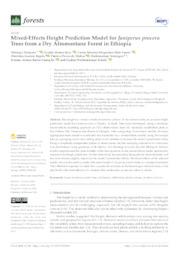Mixed-effects height prediction model for Juniperus procera trees from a Dry Afromontane Forest in Ethiopia.
Mixed-effects height prediction model for Juniperus procera trees from a Dry Afromontane Forest in Ethiopia.
Author(s): TESHOME, M.; BRAZ, E. M.; TORRES, C. M. M. E.; RAPTIS, D. I.; MATTOS, P. P. de; TEMESGEN, H.; RUBIO-CAMACHO, E. A.; SILESHI, G. W.
Summary: Tree height is a crucial variable in forestry science. In the current study, an accurate height prediction model for Juniperus procera Hochst. ex Endl. trees were developed, using a nonlinear mixed-effects modeling approach on 1215 observations from 101 randomly established plots in the Chilimo Dry Afromontane Forest in Ethiopia. After comparing 14 nonlinear models, the most appropriate base model was selected and expanded as a mixed-effects model, using the sample plot as a grouping factor, and adding stand-level variables to increase the model’s prediction ability. Using a completely independent dataset of observations, the best sampling alternative for calibration was determined using goodness-of-fit criteria. Our findings revealed that the Michaelis–Menten model outperformed the other models, while the expansion to the mixed-effects model significantly improved the height prediction. On the other hand, incorporating the quadratic mean diameter and the stem density slightly improved the model’s prediction ability. The fixed-effects of the selected model can also be used to predict the mean height of Juniperus procera trees as a marginal solution. The calibration response revealed that a systematic selection of the three largest-diameter trees at the plot level is the most effective for random effect estimation across new plots or stands.
Publication year: 2024
Types of publication: Journal article
Unit: Embrapa Forestry
Observation
Some of Embrapa's publications are published as ePub files. To read them, use or download one of the following free software options to your computer or mobile device. Android: Google Play Books; IOS: iBooks; Windows and Linux: Calibre.
Access other publications
Access the Agricultural Research Database (BDPA) to consult Embrapa's full library collection and records.
Visit Embrapa Bookstore to purchase books and other publications sold by Embrapa.

